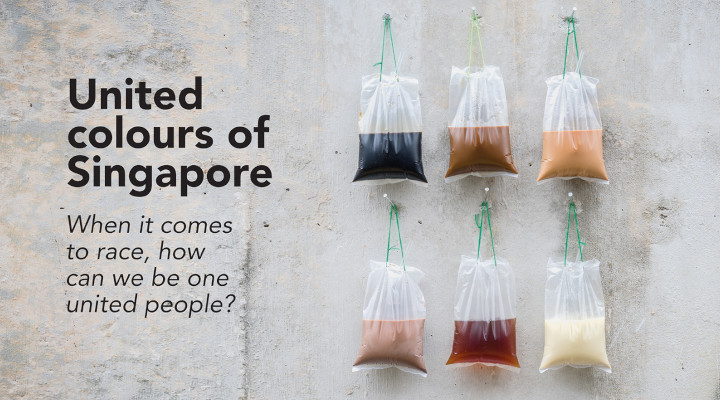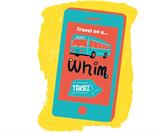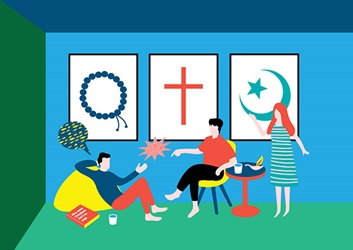Let's Talk About Race

Before We Begin
Updated: June 28, 2021
When this story on race in Singapore was conceptualised for the print issue in 2017, we aimed to portray a potentially touchy issue in a visually arresting and less predictable way, without using individuals' faces. We started with an idea to use the Pantone colour chart to show different shades of skin colours. After considering several options, we chose the concept of showing diversity through a display of favourite local drinks, using different mixes of kopi, teh, Milo and soy milk. Visually, it played on the colloquial local phrase “lim kopi”, which means to have a chat over coffee.
The visuals are combined with the headline “United colours of Singapore” and a subtitle of “When it comes to race, how can we truly be one united people?” The headline evokes the brand United Colours of Benetton, known for its use of diverse models in its branding and advertisements. Meanwhile, the subtitle echoes a familiar phrase from the Singapore national pledge, which has as its opening line: “We, the citizens of Singapore, pledge ourselves as one united people. Words and visuals combined, the intended effect is to bring out a sense of community and coming together, even as the topic of race could be contentious.
Since then, sentiments about race representation and the CMIO may have changed. Tell us what you think at psd_challenge@psd.gov.sg
Are you racially biased? The answer from almost anyone in Singapore would likely be “no” – if the question were even asked in the first place. After all, racial harmony is a core value of this country, where multiracialism is fundamental to national identity.
Dig a little deeper, though, and the reality seems different. Racial bias is still common in Singapore, as revealed in “Regardless of Race”, a documentary that aired on Channel NewsAsia (CNA) in August last year, featuring head of OnePeople.sg Dr Janil Puthucheary (watch: bit.ly/regardlessrace).
In the documentary, a taxi driver interviewed said he was not racist, and then went on to share: “We don’t like Indian customers. They speak too loudly. We like Malay customers best. They don’t give us trouble.” Also featured was Mr Sanif Sarip, whose Facebook post about facing racism went viral after he recounted a boy telling him in a cinema: “I don’t want to sit beside Malay people.”
Bloggers have raised the issue as well. On ChutneySg, a bilingual English-Tamil site, Ms Hemma Balakrishnan wrote: “As a minority person … in Singapore, I have experienced my fair share of racism. This could range from the intentionally racist slurs to the less malicious (but nonetheless painful) casual racism.”
Rocking the Boat
So why do we need to talk about race? The reason is simple: both subtle and overt racial discrimination continues to create real problems in people’s everyday lives. A survey by home rental portal 99.co showed that its users experienced racial discrimination 20% of the time.
To combat such racial profiling, global short-term home rental service AirBnB updated its policies and practices.
Users must now sign a “community commitment” statement, and the company has put in place systems to prevent hosts from rejecting certain guests while accepting others, and more instant bookings without screening.
The CNA-IPS survey also showed that a fifth of Singaporeans surveyed believe that not hiring someone based on their race is not racist.
Despite guidelines from the Tripartite Alliance for Fair and Progressive Employment Practices that job candidates be selected based on criteria necessary for the role, incidents of discriminatory hiring still occur.
A Malay candidate for a job at PrimaDeli was told at an interview: “From what I see, and the way you look, and not trying to be racist ah, but you Malay, I think you cannot lah.” The hiring manager was fired after the candidate’s Facebook post about the encounter went viral.

Anecdotes aside, Institute of Policy Studies (IPS) Senior Research Fellow Mathew Mathews, who specialises in society and identity, agrees that racial bias can be a real issue in Singapore for some.
“Harmony is still a work in progress. Deep down inside, stereotypes and prejudices are still there,” said Dr Mathews, whose research focuses on Singapore’s social policies and social cohesion, covering topics of race, religion and immigrant integration.
This is despite years of government efforts to bring people of different races together: public housing policies that prevent the clustering of any single racial group; the creation of common spaces, such as schools, void decks and playgrounds, where people across races can meet and interact; and even rites of passage for Singaporeans, such as National Service.
Race is also a taboo topic in conversations, as people fear saying the wrong thing. About two-thirds of respondents in a CNA-IPS poll in 2016 noted that discussions of race could lead to tension. “Race has always been deemed a sensitive issue. We don’t want to broach subjects which make others uneasy,” Dr Mathews told Challenge.
Underscoring this, host Dr Puthucheary wrapped up the “Regardless of Race” documentary saying he was surprised the film got made at all.
Clearly, then, there is still a mismatch between expectations of racial harmony and reality, and people are uncomfortable talking about it. Whether that disconnect is due to people being unaware of the real situation, fearing being called racist or not realising they have biases, finding solutions to reduce racial bias and discrimination is essential.
With changing demographics in Singapore that could result in increased tensions, addressing racial issues is more important than ever.
But how can we get people to talk about race more openly?
Sustain Conversations for Sustained Change
Discussions about race are a good way to start, Dr Mathews said. “If more people are informed about the issues, they become more aware of how to be sensitive to the needs of different communities.”
Dr Puthucheary concurred: “Conversation may not be sufficient, but it is important, to get people to where they acknowledge ethnic issues exist.
“Once we get the conversation going, what people discover is what they worry about is common to a large number of people.”
But researcher Kira Banks from St Louis University has found that one-off dialogues are quickly forgotten.

She suggests that organisations make long-term investments in inclusion to foster ongoing discussions that lead to sustained change.
Dialogue leaders can be taught facilitation skills that include listening, being colour-cognisant rather than colour-blind (see sidebox), responding non-defensively, and self-reflecting about how personal and social identities can influence interactions.
With more public officers being trained to be conversation facilitators, tapping them as well as external facilitators – such as those in the Our Singapore Conversation and SGfuture dialogues – could allow for more long-term discussions around race.
Dr Mathews also suggested that formal programmes could help reduce biases in the Public Service, schools, National Service and community organisations. This will help create enough “champions” who are comfortable with sharing their understanding or righting wrong perceptions within their circle of friends and family.
When discussions do happen, dialogues should lead to points of action, emphasising two areas, suggested Dr Puthucheary: “First, understanding that biases are present in everybody. Second, we then need to be intentional about looking for areas where bias may affect the delivery of our service, then take steps to mitigate those effects.”
Identify Innate Biases
Along with talking about racial issues, other tools may help people identify and reduce innate racial biases.
As Pew Research Center editor Rich Morin wrote in a report exploring racial bias (bit.ly/biasIAT): “Biased racial views are sometimes buried deep in a person’s subconscious – the by-products of exposure to popular culture, the media and other factors.”
One solution is using assessments such as the Implicit Association Test (IAT), which measures subconscious or “hidden” bias. When Pew Research Center conducted the IAT in the US, it found that about three-quarters of respondents demonstrated some degree of implicit racial bias. Once people understand themselves better, they can act to reduce such bias.
In Singapore, since public officers serve people of different races and may even have to mediate between them, using tools like the IAT could help officers become aware of any unconscious biases.

Ensure Fair and Diverse Hiring
To increase diversity in organisations, Harvard professor Frank Dobbin has suggested applying three basic principles: engage managers in solving the problem, expose them to people from different groups, and encourage social accountability for change. (Read more: bit.ly/diversityp).
Increasing the number of job boards, requiring diversity in hiring panels, and having company leaders demonstrate disapproval of discriminatory treatment are among the many additional effective practices to increase diversity in hiring.
In Canada, for instance, the DiverseCity onBoard initiative has a searchable database that matches qualified individuals from under-represented communities with board opportunities, allowing for greater representation and diversity in leadership.
Create More Opportunities To Mingle
Research shows that cross-group friendships help decrease prejudice. This is something the Singapore government has known for a long time – hence the proliferation of common spaces where children of all races and socioeconomic groups can play and interact.
Schools then have a critical role to play in reducing racial stereotyping. Teachers can do their part by exposing children to positive role models of inter-group friendships. Using books featuring cross-racial friendships in a positive light, for instance, can help.
Educators can also encourage the cross-group friendships to break down prejudice. Engaging diverse groups of students in cooperative tasks in the classroom by having them work in ethnically mixed learning groups, for instance, has been shown to increase crossethnic friendships.
Teachers can also tackle racism head-on by challenging students who assign negative characteristics to people of different races by countering with positive statements.
At the National Institute of Education, the Meranti project facilitates discussion among educators on working with diversity in the classroom. This helps to reduce bias among educators first so that they can go on to help reduce racial bias in their students. Incorporating these and other practices into lesson plans and classroom practices, rather than adding on separate responsibilities for teaching about racial understanding, can have a positive impact while also minimising the burden on already-overworked teachers.
Beyond schools, increasing opportunities for crossracial interaction that lead to friendships in offices, residential areas and a multitude of other places could be beneficial.
Review Policies for Biases
While dialogues and a variety of other practices to encourage racial harmony and reduce bias are important, unintentional bias may still be present in existing policies.
Singapore made a significant move in signing the UN International Convention on the Elimination of All Forms of Racial Discrimination (ICERD) in 2015. That means Singapore is obligated to ensure that its policies do not allow racial discrimination. With the aim to ratify the UN pact in 2017, an inter-ministry committee led by the Ministry of Culture, Community and Youth (MCCY) will engage with community partners, including ethnic-based organisations; review policies for improvement and propose new initiatives to combat racial discrimination.
One policy that has stirred debates in forums, academic circles and on social media is the Chinese-Malay-Indian-Other (CMIO) model. It has been the de facto way of dealing with ethnic diversity in Singapore, with policies ranging from mother tongue to the Ethnic Integration Policy. While the CMIO model has its benefits, it may also confirm racial demarcations or cause disparities such as different sales price of HDB flats depending upon race. The CMIO model has also become far more complex, especially with the increase in inter-racial marriages from 13% a decade ago to 20% in 2014.
That said, some groups may prefer the model to continue. Former Banyan Tree Executive Chairman Ho Kwon Ping, who had said in an April 2016 lecture that the CMIO’s racial categories should be “consciously blurred or even abolished”, backtracked after several of his minority friends expressed worry that the government would stop signaling the importance of recognising the Malay and Indian minorities.
Keeping the Conversation Going
While existing initiatives to foster racial harmony have had positive effects, it is important to expand discussions and take even more action.

As Dr Puthucheary said, such initiatives “cannot be left to chance”. The MCCY has a Harmony Fund (bit.ly/MHFund) and Our Singapore Fund to support citizen-led projects that bring people of different races together to have dialogues about race, such as More Than Just, a three-part dinner conversation series running from March to April 2017 (morethanjust.sg).
With more of such dialogues and initiatives to foster understanding, Singapore can get closer to its goal of reducing racial biases and truly making racial harmony a reality.
Colour Blindness vs Colour Cognisance

University of Connecticut professor Dr Monnica Williams observed that, “at face value, colour-blindness seems like a good thing… It focuses on commonalities between people.” The issue, though, is that colour-blindness can create a society that denies negative racial experiences. The alternative to colour-blindness, said Dr Williams, is multiculturalism, which acknowledges and celebrates ethno-racial differences. And in The Color Bind, workplace experts Erica Foldy and Tamara Buckley write that colour cognisance recognises the profound impact of race and ethnicity on life experiences while affirming the importance of racial diversity.
- POSTED ON
Apr 4, 2017
- TEXT BY
Richard Hartung
- PHOTOS BY
Catspace
-
Deep Dive
Strengthening Singapore’s Food Security
-
Feature
Let's Talk About Religion
-
Profile
Bursting Filter Bubbles









